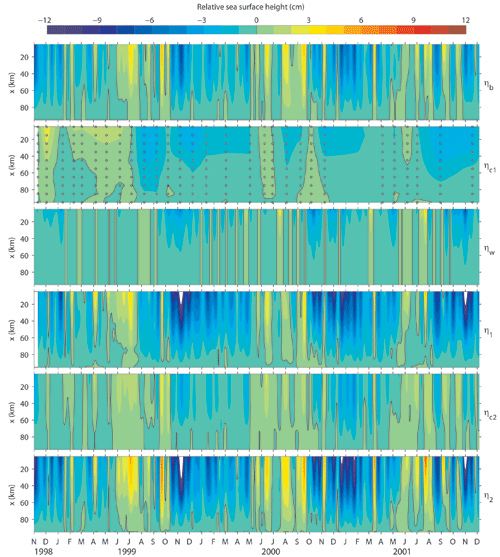Ocean Currents and Sea Surface Heights Estimated across the West Florida Shelf
|
The across-shelf structures of the ocean circulation and the associated sea surface height (SSH) variability are examined on the west Florida shelf (WFS) for the 3-yr interval from September 1998 to December 2001. Five sets of characteristic circulation patterns are extracted from 2-day, low-pass-filtered data using the self-organizing map: extreme upwelling and downwelling structures with strong currents, asymmetric upwelling and downwelling structures with moderate currents, and a set of transitional structures with weak currents. The temporal variations of these structures are coherent with the local winds on synoptic weather time scales. On seasonal time scales they are related to both the local winds and the water density variations. The circulation is predominantly upwelling during autumn to spring months (October–April) and downwelling during summer months (June–September). Coastal sea level fluctuations are related to both the dynamical responses of the inner shelf circulation to meteorological forcing and the offshore SSH. On long time scales, the offshore SSH variations appear to dominate, whereas on synoptic weather time scales, the inner shelf wind-driven circulation responses are largest. The across-shelf distribution of SSH is estimated from the velocity, hydrography, wind, and coastal sea level data, and the results are compared with satellite altimetry data, thereby providing a means for calibrating satellite altimetry on the shelf. More details can be seen in Liu and Weisberg [2007]. References: Liu, Y., and R.H. Weisberg, 2005: Patterns of ocean current variability on the West Florida Shelf using the self-organizing map. Journal of Geophysical Research, 110, C06003, doi:10.1029/2004JC002786. Liu, Y., and R.H. Weisberg, 2005: Momentum balance diagnoses for the West Florida Shelf. Continental Shelf Research, 25, 2054-2074. Liu, Y., and R.H. Weisberg, 2007: Ocean currents and sea surface heights estimated across the West Florida Shelf. Journal of Physical Oceanography, 37(6), 1697-1713. |
SSH estimates relative to that at the 50-m site as a function of time and distance from coast (x). (top to bottom) The SSH components due to the barotropic currents, the baroclinic currents (estimated from the hydrographic data that are designated by the small open circles), and the across-shelf wind stress); the total relative SSH; the SSH component due to baroclinic currents (estimated from the velocity vertical shears); and the total relative SSH, respectively. |
See the citations of this paper [Liu and Weisberg, 2007] in Google Scholar.
